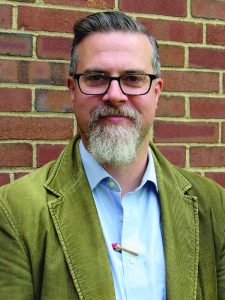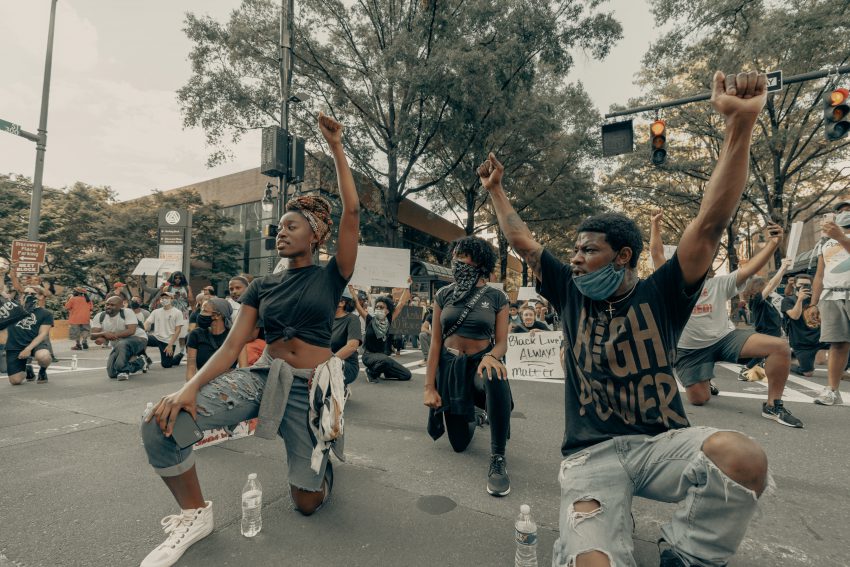As Black History Month comes to a close, Lecturer in Theology and Ethics Dr. Derek Woodard-Lehman examines parallels between the American Civil Rights Movement and the Anti-Apartheid Movement in South Africa, believing them to be informative for continued racial justice work today.
Julian Bond often summarized the average American’s understanding of the Civil Rights Movement like this: “Rosa sat down. Martin stood up. The white kids came down and saved the day.” Bond, an activist in the Student Nonviolent Coordinating Committee (SNCC) and later president of the National Association for the Advancement of Colored People (NAACP), had in mind a pair of events that bookend the most intense phase of the Movement: the 1955 Montgomery Bus Boycott and the 1964 Freedom Summer. These events, along with King’s “I Have a Dream” speech during the 1963 March on Washington, feature charismatic leaders and cinematic images that capture the popular imagination. These moments understandably have come to stand in for the Movement as a whole. However, these stand-ins leave out the most important parts of the Movement.
Rosa Parks
On most tellings, Rosa Parks spontaneously “just decided one day” not to give up her seat to a white person on that bus. Her action indeed was decisive. But it was not impulsive. Parks had been active in her local NAACP chapter since 1943. She had given a plenary address at the Association’s 1948 statewide convention. In between, she attended two of its national leadership conferences. And just four months before Parks took her stand by keeping her seat, she participated in a two-week long workshop at the Highlander Folk School to strategize about how to “implement” the desegregation mandate of the Brown v. Board Supreme Court Decision. Her act of insistent defiance was not an isolated occurrence. It was preceded by more than a decade of patient resistance. And in a 1967 interview, Parks herself stated, “I had felt for a long time, that if I ever was told to get up so a white person could sit, I would refuse to do so.”
A Larger, Longer Movement
As with so many iconic episodes in the Movement, a larger and longer retelling is both more illuminating and more inspiring than the textbook narrative. Civil Rights did not begin in Montgomery and end in Memphis with Martin Luther King Jr. The Movement reaches back to the 1890s anti-lynching campaigns of Ida B. Wells. It stretches forward to the 1970s Black Power activism of Kwame Toure. Behind canonical heroes like King and Parks, between historic headlines like Montgomery and Washington, are thousands of ordinary citizens whose everyday actions generated the Movement’s real power.
Ella Baker
Ella Baker, the mother of the Movement and Rosa Parks’ mentor, had spent decades organizing local chapters of the NAACP. This before midwifing the birth of King’s Southern Christian Leadership Conference (SCLC). Seeing the courage and commitment of student sit-ins across the South, Baker helped form the Student Nonviolent Coordinating Committee (SNCC). Because she organized it as an independent student-led organization, SNCC was able to press the issue of civil disobedience while King and the SCLC remained reluctant to engage in direct confrontation with Jim Crow.
Many leaders whom Baker had recruited and mentored through the NAACP during the 1940s and 1950s later were mobilized through SNCC in the 1960s. Chief among them were Amzie Moore, C. C. Bryant, and E. W. Steptoe. They, along with many other elder activists like Fannie Lou Hamer, collaborated with Bob Moses to organize SNCC’s Mississippi Voter Registration Campaigns. SNCC’s painstaking local organizing made possible the more eye-catching mass mobilizing of the SCLC. Although King’s big speeches and the SCLC’s mass marches are the most memorable images of the Movement, SNCC’s humble “spade work,” as Baker called it, is its most characteristic image. Ordinary citizens talking to each other in small groups. Sometimes on front porches in the rural South. Oftentimes in church fellowship halls in Southern towns and cities.
Students Leading the Way
More often than not, those facilitating such conversations were students. Many of them came from church-related colleges and denominational seminaries. Leaders like Diane Nash and James Lawson, Jane Stembridge and Jonathan Daniels, Colia Liddell and John Lewis. The struggle for Civil Rights is cast as a faith-based social movement. But, we need to recast it as much more than what the textbook narratives depict as a clergy-led “preacherocracy.” Yes, the Black church and its clergy were prominent in the Movement. Yes, King was its preeminent spokesperson. But it was everyday church folk and ordinary students who were its predominant leaders.
Jim Crow and Apartheid
The story of the South African Church Struggle is much the same. The parallels between Apartheid South Africa and Jim Crow America are striking, so much so that Jim Crow has been called “American Apartheid.” Like the Civil Rights Movement, the Anti-Apartheid Movement features prominent clergy among its most important leaders. Anglican Bishop Desmond Tutu was most celebrated. But given the deeply Calvinist character of South African society, Reformed pastor and theologian Alan Boesak was the most influential.
Boesak’s renown is well-earned. After completing a groundbreaking doctoral dissertation on liberation theology in the Netherlands, he returned to South Africa to serve as a chaplain at University of the Western Cape (UWC). The segregated university in Cape Town was a hotbed for campus protests following the 1967 Soweto massacre. Boesak became an important mentor for student activists, as well as an outspoken advocate of what he called “a theology of refusal.” He founded the Association of Black Reformed Christians in South Africa (ABRECSA) and delivered his famous “Black and Reformed” speech at its 1981 inaugural meeting. The following year, he presided at the global assembly of the World Alliance of Reformed Churches which declared Apartheid to be a heresy.
The Belhar Confession
However, as with King, Boesak’s shadow obscures the work and witness of countless others, including those most responsible for drafting the 1982 Belhar Confession that denounced the racism of Apartheid and demanded that the church “stand where the Lord stands, namely against injustice and with the wronged.” Indeed, because he moderated the Synod at which Belhar was adopted, Eugene Fortein remarks, “For years, the names ‘Boesak’ and ‘Belhar’ were synonymous.” Yet, for all his influence on the Anti-Apartheid Movement and the Confessing Church, he was largely absent from the writing of Belhar itself.
The “Theological Essence” of Resistance
Like the leaders of the Civil Rights Movement, the most important authors of Belhar were students. During a 1978 theology seminar, Jaap Durand, and outspoken Afrikaner opponent of Apartheid teaching at UWC, asked his students to discern the “theological essence” of their resistance. At the time, they were reading portions of Karl Barth’s Church Dogmatics. Their answer, reported by Russel Botman, was that, “Apartheid has as its point of departure the irreconcilability of the races. It is, thus, against the heart of the gospel of Jesus Christ, which takes its point of departure in the doctrine of reconciliation.” Apartheid was not only an unjust social structure. It was a false gospel.
Not content for their insight to remain purely academic, with Durand’s help, the students drafted a proposal to the 1978 General Synod of the Dutch Reformed Mission Church (DRMC). The Synod considered their Proposal and adopted it as their own resolution. This reversed their 1950 decision to “refrain from entering the political terrain by approving or rejecting a political policy.” Four years later, in 1982, their professor, Jaap Durand, and his colleague Dirk Smit used their proposal as a template for the Belhar Confession. At these crucial junctures, students led; their teachers and their church followed.
Who Will Lead Us Now?
Revisiting these events and revising our understanding of them is not an idle historical exercise. We must expand our recollection of these past struggles and the role of students in them so that we can enlarge our expectation for student leadership in contemporary movements like Black Lives Matter. The success of today’s movements does not depend on the latter day coming of another singular charismatic leader like King. It depends rather on developing cadres of democratic leaders like Diane Nash and Bob Moses. More importantly, it demands not postponing student leadership to some distant future after graduation and following ordination, but instead positioning students to lead today amidst the fierce urgency of now. And mostly that means following the lead of Ella Baker and Jaap Durand by positioning ourselves to follow them.
 Dr. Derek Woodard Lehman is the seminary advancement coordinator at Pittsburgh Theological Seminary, where he also serves on the faculty as a lecturer in theology and ethics.
Dr. Derek Woodard Lehman is the seminary advancement coordinator at Pittsburgh Theological Seminary, where he also serves on the faculty as a lecturer in theology and ethics.

